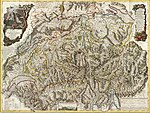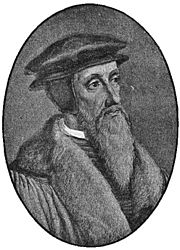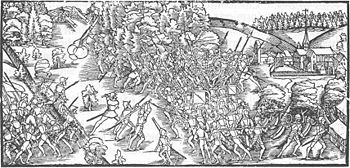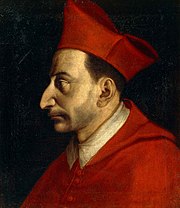Reformation in Switzerland
| History of Switzerland |
|---|
 |
| Early history |
|
| Old Swiss Confederacy |
|
| Transitional period |
|
| Modern history |
|
| Timeline |
| Topical |
|
|
|


The Protestant Reformation in Switzerland was promoted initially by
Despite their religious differences and an exclusively Catholic defence alliance of the seven cantons (Goldener Bund), no other major armed conflicts directly between the cantons occurred. Soldiers from both sides fought in the French Wars of Religion.
During the
Development of Protestantism
After the violent conflicts of the late 15th century, the Swiss cantons had had a generation of relative political stability.[1] As part of their struggle for independence, they had already in the 15th century sought to limit the influence of the Church on their political sovereignty. Many monasteries had already come under secular supervision, and the administration of schools was in the hands of the cantons, although the teachers generally still were priests.
Nevertheless, many of the problems of the Church also existed in the Swiss Confederacy. Many a cleric, as well as the Church as a whole, enjoyed a luxurious lifestyle in stark contrast to the conditions of the large majority of the population; this luxury was financed by high church taxes and abundant sale of indulgences. Many priests were poorly educated, and spiritual Church doctrines were often disregarded. Many priests did not live in celibacy but in concubinage. The new reformatory ideas thus fell on fertile ground.

The main proponent of the Reformation in Switzerland was

In the following two years, profound changes took place in Zürich. The Church was thoroughly secularised. Priests were relieved from celibacy and the opulent decorations in the churches were thrown out. The state assumed the administration of Church properties, financing the social works (which up to then were managed entirely by the Church), and also paid the priests. The last abbess of the Fraumünster, Katharina von Zimmern, turned over the convent including all of its rights and possessions to the city authorities on 30 November 1524. She even married the next year.

Over the next few years, the cities of
Despite their conversion to Protestantism, the citizens of Geneva were not ready to adopt
In search of a common theology
Zwingli, who had studied in Basel at the same time as

After Zwingli's death,
Religious civil war

The success of the Reformation in Zürich and its rapid territorial expansion definitely made this religious renewal a political issue and a major source of conflict between the thirteen cantons. The alpine cantons of Uri, Schwyz, Unterwalden, Lucerne, and Zug remained staunchly Catholic. Their opposition was not uniquely a question of faith; economic reasons also played a role. Besides on agriculture, their economy depended to a large degree on the mercenary services and the financial recompensations for the same. They could not afford to lose this source of income, which was a major target of reformatory criticism. In contrast, the cities' economies were more diversified, including strong crafts and guilds as well as a budding industrial sector. Fribourg and Solothurn also remained Catholic.
The five alpine cantons perceived the Reformation as a threat early on; already in 1524 they formed the "League of the Five Cantons" (Bund der fünf Orte) to combat the spreading of the new faith. Both sides tried to strengthen their positions by concluding defensive alliances with third parties: the Protestant cantons formed a city alliance, including the Protestant cities of Konstanz and Strasbourg (Christliches Burgrecht), translated variously as Cristian Civic Union, Christian Co-burghery, Christian Confederation and Christian Federation (in Latin Zwingli called it Civitas Christiana or Christian State); the Catholic ones entered a pact with Ferdinand of Austria.
In the tense atmosphere, small incidents could easily escalate. Conflicts arose especially over the situation in the common territories, where the administration changed bi-annually among cantons and thus switched between Catholic and Protestant rules. Several mediation attempts failed such as the disputation of Baden in 1526.
After numerous minor incidents and provocations from both sides, a Protestant pastor was burned on the stake in Schwyz in 1529, and in retaliation Zürich declared war. By mediation of the other cantons, open war (known as the

Two years later, the
When their Protestant city alliance was dissolved, Zürich and the southern German cities joined the Schmalkaldic League, but in the German religious wars of 1546/47, Zürich and the other Swiss Protestant cantons remained strictly neutral. With the victory of Charles V the previously close relations to the Swabian Protestant cities in the Holy Roman Empire were severed: many cities, like Konstanz, were re-Catholicised and many were placed under a strictly aristocratic rule.
Counter-Reformation

While the official Church remained passive during the beginnings of the Reformation, the Swiss Catholic cantons took measures early on to keep the new movement at bay. They assumed judicial and financial powers over the clergy, laid down firm rules of conduct for the priests, outlawed concubinage, and reserved the right to nominate priests in the first place, who previously had been assigned by the bishoprics. They also banned printing, distributing, and possessing Reformist tracts; and banned the study of Hebrew and Greek (to put an end to the independent study of biblical sources). Overall, these measures were successful: not only did they prevent the spreading of the Reformation into the Catholic cantons but also they made the Church dependent on the state and generally strengthened the power of the civil authorities.

The Catholic cantons also maintained their domination of the Catholic Church after the
Parallel to these efforts to reform the Catholic Church, the Catholic cantons also proceeded to re-Catholicize regions that had converted to Protestantism. Besides reconversions in the common territories, the Catholic cantons in 1560 first tried to undo the Reformation in Glarus, where the Catholics were a minority.
The five Catholic cantons formed a military alliance with the Pope and the Catholic Duchy of Savoy, and had the support of Aegidius Tschudi, the Landammann (chief magistrate) of Glarus. But due to lack of money, they could not intervene in Glarus by force. In 1564, they settled for a treaty which prescribed the separation of religions in Glarus. There were henceforth two legislative assemblies (Landsgemeinde) in the canton, a Catholic and a Protestant one, and Glarus would send one Catholic and one Protestant representative each to the Tagsatzung.
The
Developments in the west
The
The alliance of 1560 of the Catholic cantons with Savoy encouraged duke

Mercenaries of the Swiss cantons participated in the
Since 1586, the duke of Savoy, Charles Emmanuel I, had placed Geneva under an embargo. With the new situation of 1589, the city now got support not only from Bern but also from the French king, and it went to war. The war between Geneva and Savoy continued even after the Peace of Vervins and the Edict of Nantes in 1598, which ended the wars in France proper. In the night from 11 to 12 December 1602, the duke's troops unsuccessfully tried to storm the city, which definitely maintained its independence from Savoy in the peace of Saint Julien, concluded in the following summer. The rebuttal of this attack, L'Escalade, is still commemorated in Geneva today.
Also in 1586, a Catholic coup d'état in Mulhouse, an associate of the confederacy, prompted the military intervention of the Protestant cantons, which quickly restored the old Protestant order. Strasbourg, another Protestant city, wanted to join the confederacy in 1588, but like Geneva some twenty years earlier, it was rejected by the Catholic cantons. In the Valais, the Reformation had had some success especially in the lower part of the Rhône valley. However, in 1603 the Catholic cantons intervened, and with their support re-Catholicisation succeeded and the Protestant families had to emigrate.
Thirty Years' War

During the
Despite the cantons' religious differences, the
The
France intervened a first time in 1624, but succeeded to drive the Spanish out of the Grisons only in 1636. However, Henri de Rohan's French army had to withdraw following the political intrigues of
The mayor of Basel,
Social developments

Historians count 13 (
Absolutism on the rise
This population growth caused significant changes in a
Persecution of heretics
The generally widespread intolerance of the time, as witnessed by the
There was no individual
The 16th century also saw the height of
Science and arts: the Renaissance in Switzerland

Many
See also
- First War of Villmergen
- History of the Grisons
- Swiss Reformed Church
- Toggenburg War (or Second War of Villmergen)
- Otto Zeinenger
Notes and references
The main sources used are
- Im Hof, U.: Geschichte der Schweiz, 7th ed. ISBN 3-17-017051-1.
- Schwabe & Co.: Geschichte der Schweiz und der Schweizer, Schwabe & Co 1986/2004. ISBN 3-7965-2067-7.
Other sources:
- ^ Norman Birnbaum. The Zwinglian Reformation in Zurich // Past and Present, No.15 (Apr. 1959), p. 28.
- ISBN 978-0-8006-6310-0.
- ^ "Philip Schaff: History of the Christian Church, Volume VIII: Modern Christianity. The Swiss Reformation - Christian Classics Ethereal Library". ccel.org. Retrieved 21 November 2022.
Further reading
- Gordon, Bruce. The Swiss Reformation. ISBN 978-0-7190-5118-0.
- Miller, Andrew. Miller's Church History. 1880. Chapter 41.
- Gilbert, W.: Renaissance and Reformation. University of Kansas, Lawrence, Kansas: Carrie, 1998.
- Luck, James M.: A History of Switzerland / The First 100,000 Years: Before the Beginnings to the Days of the Present, Society for the Promotion of Science & Scholarship, Palo Alto 1986. ISBN 0-930664-06-X.
- Marabello, Thomas Quinn (2021) "The 500th Anniversary of the Swiss Reformation: How Zwingli changed and continues to impact Switzerland today," Swiss American Historical Society Review, Vol. 57: No. 1. Available at: https://scholarsarchive.byu.edu/sahs_review/vol57/iss1/3
- Ranan, David. Double Cross – The Code of the Catholic Church. Theo Press Ltd, 2006. ISBN 978-0-9554133-0-8
- Burnett, Amy Nelson and Campi, Emidio (eds.). A Companion to the Swiss Reformation, Leiden – Boston: Brill, 2016. ISBN 978-90-04-30102-3
- Guerra, C, ISBN 978-3-4874225-5-8
External links
- Reformation in Switzerland by Markus Jud. In English, also available in French and German.
- Reformation in Switzerland by "Presence Switzerland", an official body of the Swiss Confederation. (In English, available also in many other languages.)
- Bauernkrieg (1525) in German, French and Italian in the online Historical Dictionary of Switzerland.
- The Escalade in Geneva in 1602.
- The Confessio Helvetica posterior (English transcription).
- Zweiter Kappeler Landfriede, in German.


